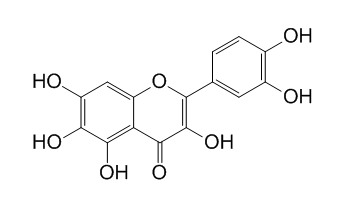Quercetagetin
Quercetagetin may be a potent inhibitor of the STAT1 signal, which could be a new molecular target for anti-inflammatory treatment, and may thus have therapeutic applications as an immune modulator in inflammatory diseases such as AD. It has stronger inhibitory effects on the protein and mRNA expression of TARC and MDC than other flavonoids.
Inquire / Order:
manager@chemfaces.com
Technical Inquiries:
service@chemfaces.com
Tel:
+86-27-84237783
Fax:
+86-27-84254680
Address:
1 Building, No. 83, CheCheng Rd., Wuhan Economic and Technological Development Zone, Wuhan, Hubei 430056, PRC
Providing storage is as stated on the product vial and the vial is kept tightly sealed, the product can be stored for up to
24 months(2-8C).
Wherever possible, you should prepare and use solutions on the same day. However, if you need to make up stock solutions in advance, we recommend that you store the solution as aliquots in tightly sealed vials at -20C. Generally, these will be useable for up to two weeks. Before use, and prior to opening the vial we recommend that you allow your product to equilibrate to room temperature for at least 1 hour.
Need more advice on solubility, usage and handling? Please email to: service@chemfaces.com
The packaging of the product may have turned upside down during transportation, resulting in the natural compounds adhering to the neck or cap of the vial. take the vial out of its packaging and gently shake to let the compounds fall to the bottom of the vial. for liquid products, centrifuge at 200-500 RPM to gather the liquid at the bottom of the vial. try to avoid loss or contamination during handling.
Molecules2022, 27(12):3903.
Int J Mol Sci.2024, 25(2):764.
Planta Med.2016, 82(13):1208-16
Molecules.2019, 24(9):E1719
Biocell2023, 47(8):1793-1802
Preprints2024, 2085.v1
Journal of Apiculture2019, 34(2):131-136
Evid Based Complement Alternat Med.2022, 2022:1307173.
Mol Neurobiol.2021, 58(8):3665-3676.
Translational Neuroscience2024, 15:20220339
Related and Featured Products
Jaceidin
Catalog No: CFN99032
CAS No: 10173-01-0
Price: Inquiry(manager@chemfaces.com)
Jaceidin triacetate
Catalog No: CFN99482
CAS No: 14397-69-4
Price: Inquiry(manager@chemfaces.com)
Chrysosplenetin
Catalog No: CFN97026
CAS No: 603-56-5
Price: $138/20mg
4',5,7-Trihydroxy 3,3',6,8-tetramethoxyflavone
Catalog No: CFN70415
CAS No: 58130-91-9
Price: Inquiry(manager@chemfaces.com)
3',4',7,8-Tetramethoxyflavone
Catalog No: CFN70432
CAS No: 65548-55-2
Price: $100/20mg
4'-hydroxy-6,7,8,3'-tetramethoxyflavonol
Catalog No: CFN91846
CAS No: 1879030-01-9
Price: $318/5mg
5,7,3',4'-Tetramethoxyflavone
Catalog No: CFN91116
CAS No: 855-97-0
Price: $30/20mg
Retusin
Catalog No: CFN89520
CAS No: 1245-15-4
Price: $158/10mg
Quercetin 3,5,7,3,4-pentamethyl ether
Catalog No: CFN70262
CAS No: 1247-97-8
Price: Inquiry(manager@chemfaces.com)
Artemetin
Catalog No: CFN98731
CAS No: 479-90-3
Price: $80/20mg
Biomolecules and Therapeutics, 2013, 21(2):138-145.
Anti-Inflammatory Effect of Quercetagetin, an Active Component of Immature Citrus unshiu, in HaCaT Human Keratinocytes.[Pubmed:
24009872 ]
Citrus fruit contain various flavonoids that have multiple biological activities. However, the content of these flavonoids are changed during maturation and immature Citrus is known to contain larger amounts than mature. Chemokines are significant mediators for cell migration, while thymus and activation-regulated chemokine (TARC/CCL17) and macrophage-derived chemokine (MDC/CCL22) are well known as the typical inflammatory chemokines in atopic dermatitis (AD), a pruritic and chronic inflammatory skin disease. We reported recently that the EtOH extract of immature Citrus unshiu inhibits TARC and MDC production.
METHODS AND RESULTS:
Therefore, we investigated the activity of flavonoids contained in immature Citrus on TARC and MDC levels. As a result, among the various flavonoids, Quercetagetin has stronger inhibitory effects on the protein and mRNA expression of TARC and MDC than other flavonoids. Quercetagetin particularly has better activity on TARC and MDC level than quercetin. In HPLC analysis, the standard peak of Quercetagetin matches the peaks of extract of immature C. unshiu.
CONCLUSIONS:
This suggests that Quercetagetin is an anti-inflammatory component in immature C. unshiu.
Br J Dermatol. 2014 Sep;171(3):512-23.
Quercetagetin inhibits macrophage-derived chemokine in HaCaT human keratinocytes via the regulation of signal transducer and activator of transcription 1, suppressor of cytokine signalling 1 and transforming growth factor-β1.[Pubmed:
24602010 ]
Inflammatory chemokines, such as macrophage-derived chemokine (MDC/CCL22), are elevated in the serum and lesioned skin of patients with atopic dermatitis (AD), and are ligands for C-C chemokine receptor 4, which is predominantly expressed on T helper 2 lymphocytes, basophils and natural killer cells. We have previously reported that Quercetagetin has an inhibitory activity on inflammatory chemokines, which is induced by interferon (IFN)-γ and tumour necrosis factor (TNF)-α, occurring via inhibition of the signal transducer and activator of transcription 1 (STAT1) signal.
To investigate the specific mechanisms of Quercetagetin on the STAT1 signal.
METHODS AND RESULTS:
We confirmed the inhibitory activity of Quercetagetin on MDC and STAT1 in HaCaT keratinocytes. The interaction between STAT1 and IFN-γR1 was investigated using immunoprecipitation. The small interfering RNA approach was used to investigate the role of suppressor of cytokine signalling 1 (SOCS1) and transforming growth factor (TGF)-β1 induced by Quercetagetin.
Quercetagetin inhibited the expression of MDC at both the protein and mRNA levels in IFN-γ- and TNF-α-stimulated HaCaT human keratinocytes. Moreover, Quercetagetin inhibited the phosphorylation of STAT1 through upregulation of SOCS1. Increased expression of SOCS1 disrupted the binding of STAT1 to IFN-γR1. Furthermore, Quercetagetin augmented the expression of TGF-β1, which is known to modulate the immune response and inflammation.
CONCLUSIONS:
These results suggest that Quercetagetin may be a potent inhibitor of the STAT1 signal, which could be a new molecular target for anti-inflammatory treatment, and may thus have therapeutic applications as an immune modulator in inflammatory diseases such as AD.



